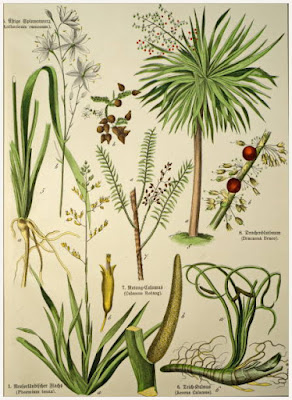Calamus - Myrtle/Sweet Flag/Sweet Sedge Flag.
Acorus calamus was an ancient East Asian plant that is also referenced in the Bible in Exodus.
The Mongolians are said to have brought it to Russia in the eleventh century, and Poland in the fourteenth.
Clausius, a Viennese botanist, extensively disseminated it towards the end of the sixteenth century.
Description - Hardy, fragrant perennial with a branching rhizome that is 3 cm thick and bears sword-shaped leaves with a wavy border that are 1 m tall and 15 mm broad.
- Early summer blooms on a 48cm long inflorescence.
Distribution - Originally from Central Asia and Eastern Europe, it is currently found in northern temperate zones, particularly in marshy areas.
Cultivation - It prefers wet soil and regular irrigation, and thrives near water sources.
- Early spring or fall, divide clumps and thoroughly cover.
Constituents - Bitter, fragrant, volatile oil with acorin as the bitter ingredient.
- Made use of as a Diaphoretic, carminative, vermifuge, spasmolytic. Salivary and stomach glands are stimulated.
- On the central nervous system, it has a little sedative effect.
- It's best for flatulent colic and dyspepsia.
- Liqueur and beer flavoring Sweetmeats made from candied rhizomes.
- Salads with young leaf buds.
- White ants are repelled by this insecticide powder.
- Orris root-like fragrance ingredient.
- Toothpowder, hair powders, and dry shampoos are all examples of powders.
- Snuff.
Contra-indications - The oil of acorus is said to be carcinogenic.





